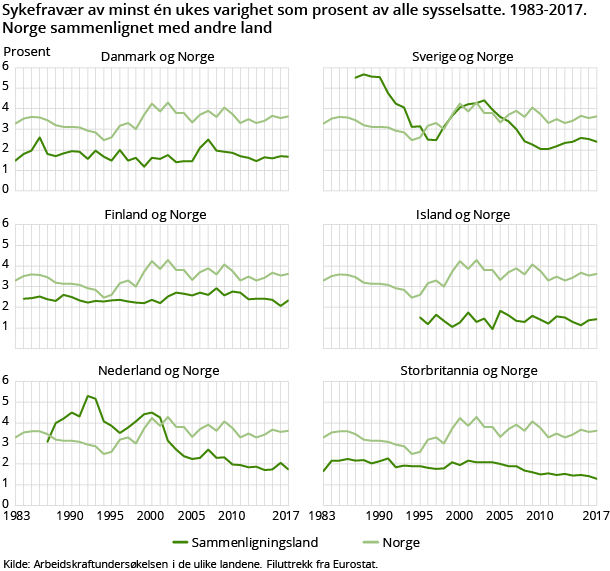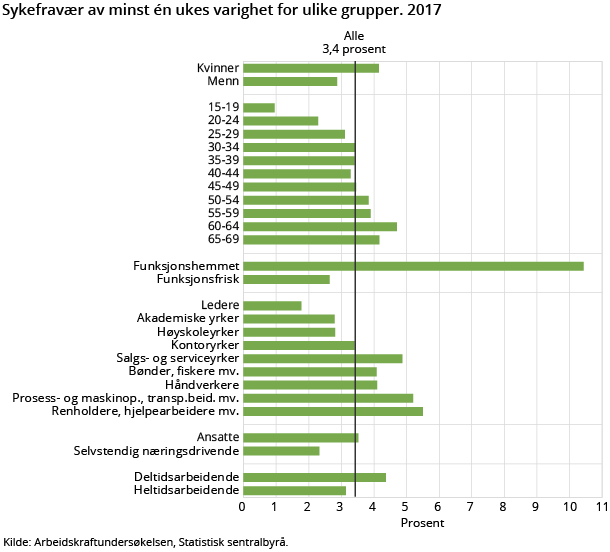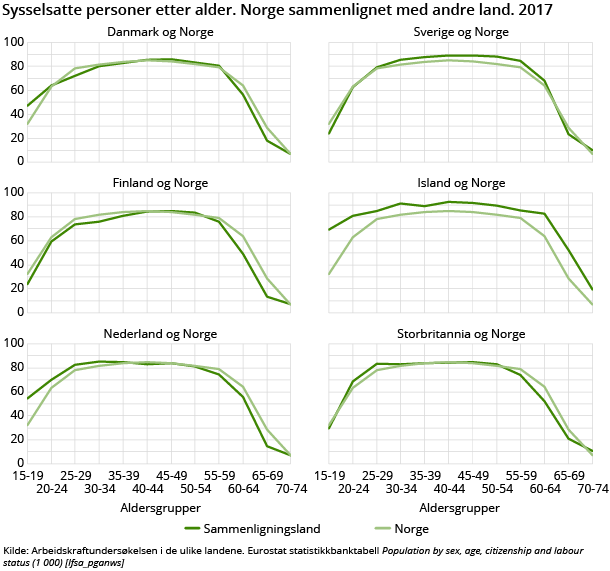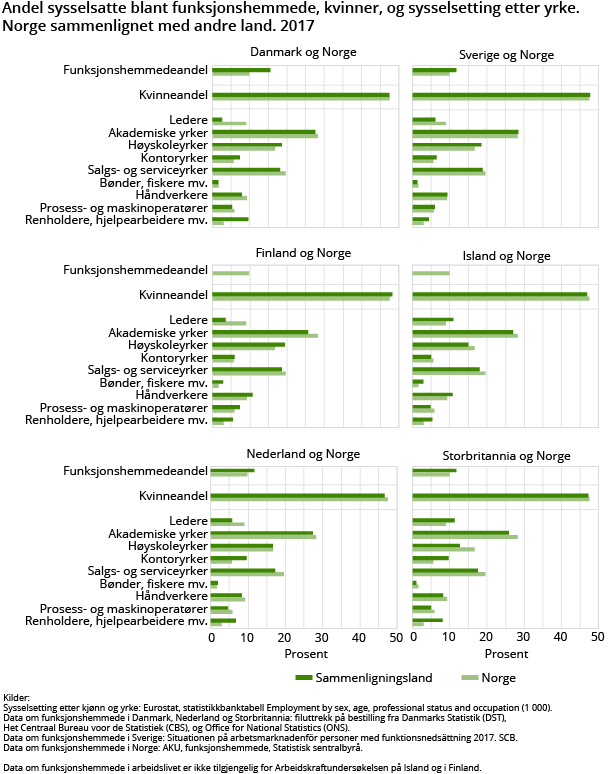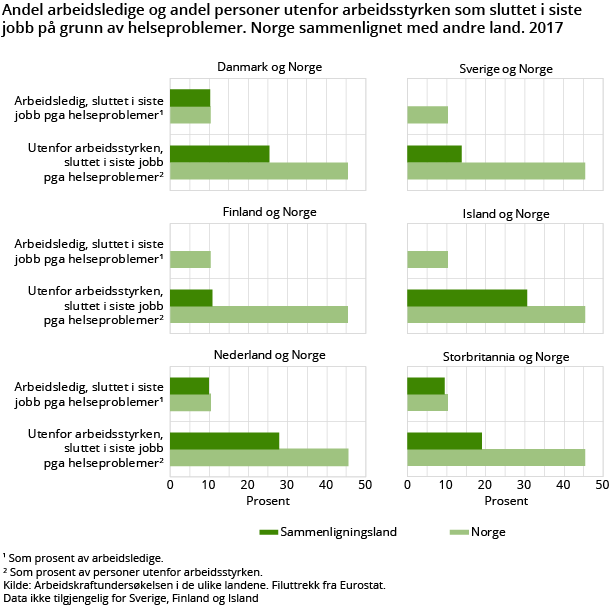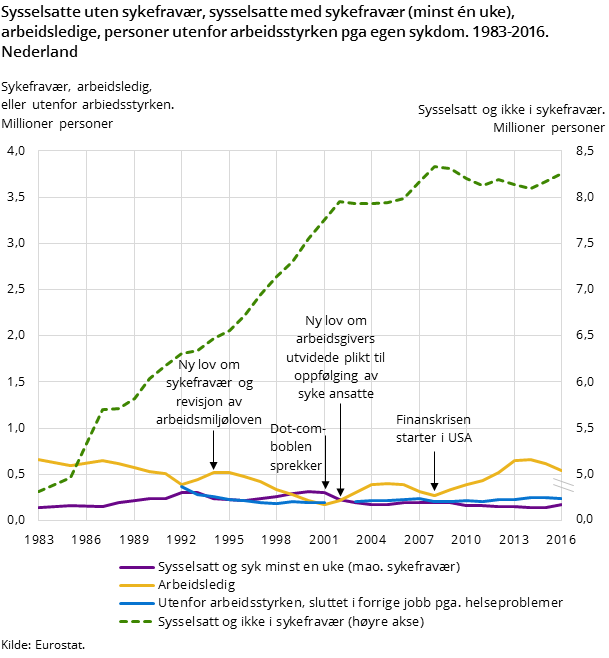According to a labor force survey, Norway had more sickness absenteeism over the past 13 years than Sweden and the Netherlands, but before the turn of the millennium the situation was different. There are indications that the Swedish and Dutch welfare reforms contributed to the differences.
The article compares sickness absence in Norway, Sweden, Denmark, Finland, Iceland, the United Kingdom and the Netherlands as a follow-up to a previous SSB publication. Sickness absence is defined here as absence from work of at least one week due to one's own health problems and is based on the responses of people interviewed in the Labor Force Survey. This does not necessarily mean that there is no justification on the part of the doctor or that it is given the person is officially declared sick in accordance with the legislation of your country.
The article consists of three main parts. In the first part of this article, we will examine whether the difference in sickness absenteeism between countries can be explained by differences in the size of the groups that are at work and who are particularly vulnerable to illness. In the second part, we will look at where those who work and who fall ill end up in different sectors:
- Do they continue their work after illness?
- Are they fully capable and are they still working in their position?
- Do they become unemployed or recipients of social benefits after illness?
Finally, we take a closer look at what happened in the Netherlands when they changed rules regarding sickness absence.
Different characteristics of working people and people not working
There are two main reasons for sickness absence In Norway differs from sickness absence in our neighboring countries: the characteristics of those who work and the character traits of those who do not work. We need to look at them separately so as not to confuse the impact, what they have on sick leave.
One specific example of the first is that certain groups of workers (disabled people and people with physical work) have statistically higher sickness absence than others. If Norwegia has more disabled people at work than our neighboring countries, this may help explain higher sickness absence.
An example of the second is that if in other countries you are more likely to lose your job when you get sick, then statistical sickness absence decreases because you must have employment in sickness absence statistics.
In both of these examples, simply looking at the sickness absence rate would likely draw the wrong conclusions about public health and public spending, since in the first case you are at home instead of working (in the case of serious illness), and in the second case, he does not recover, but drops in sickness absence statistics due to job loss
The highest sickness absence was recorded in Norway from 2006 to 2017
Before we get into the reasoning, it's worth taking a look at the long lines sick leave. Figure 1 shows absenteeism levels in the seven countries we are interested in, for all 34 years for which we have comparable data, from the study labor force. Norway (lighter line) has the highest rate compared to other countries (dark lines) since 2006. We also see that the level of Norway it was relatively constant throughout the period, while it fluctuated significantly in the Netherlands and Sweden. In other words, the reason Norway is currently higher than Sweden and the Netherlands is not because the number of absences in Norway has increased significantly, but decreased in these two countries. Comparison with Denmark, Finland, Iceland and the UK shows a different picture, as these countries have fairly equal levels of absenteeism throughout the period, with Norway being higher than them throughout the period considered.
Age, not working hours, is important for the rate of sickness absence
As presented in the introduction, the actual composition of the workforce has a direct impact to the average level of joblessness in this country. We can see that age, disability and type of profession play an important role in how often people get sick due to their own health situation, as shown in Figure 2. The figure also shows that work hours and whether he is employed or self-employed. the employee plays a smaller role. Therefore, we focus on the variables that we see here, the most relevant ones in the article.
By comparison, there are several disabled people in Norway who can withdraw their absenteeism due to illness
The next step is to examine how the countries we compare with in this article reveal these explanatory variables for sickness absence: age, disability, occupational type and gender. Do we have so much elderly or disabled people working in Sweden, and is this where the explanation lies for our higher sick leave rate?
In Figure 3 we see that there is some difference between countries in the age distribution of the working population. More seniors work in Norway than in Denmark, Finland, the Netherlands and Great Britain, while in the case of older workers it is practically the same in Sweden. Certain higher sickness absence in Norway is therefore probably a consequence of the age of those who work. But since the age difference is small, there is no clear explanation here
Moreover, in Figure 4 we see that there are no major differences in the percentage of women among working people. Norway (lighter line) actually has a small percentage of people in groupie professional workers who have the highest absences in Figure 2 (cleaners, support workers, etc.), so there is no reasonable explanation either.
We saw in Figure 2 that disability has a large impact on sickness absence. It would therefore be reasonable to assume a high rate of absenteeism sickness in Norway was related to the fact that many disabled people work, compared to other countries. Figure 4 shows that this assumption is unclear. Among the countries where we have data (Denmark, Sweden, the Netherlands, Great Britain and Norway), Norway integrates people with disabilities the worst in professional life. This cannot therefore explain why Norway has a higher rate of sick leave than comparison countries. We have no reason to assume that this difference is due to the fact that other countries should have more disabled people than Norway as a whole. Arrangements regarding the comparison between Norway and Sweden are supported by other research.
Out of work due to health problems
As mentioned in the introduction, sickness absence will have an impact also on those who do not work. Here we look at which countries are more likely to lose your job if you are sick for a long period of time and thus "help" reduce average sickness absence without counting in sickness absence figures.
"Unemployed" can mean two groups in the Labor Force Survey: either unemployed or quitting jobs. Figure 5 shows the results for both groups.
One hypothesis is that since Norway has much more people on sick leave and in other countries there are more people who they lost their jobs or have quit their job due to illness and are then unemployed or out of the work zone.
In Figure 5, we can see that, at first glance, Norway is on the same level as other countries for unemployed people who have left their previous job due to health problems. However, there are more unemployed in other countries (in 2017, Denmark meant this article, which is 35% more unemployed than in Norway). This means that even if the proportion of people unemployed because of health problems is the same, it is the majority of the population in other countries who have lost their jobs because they became ill.
Furthermore, in Figure 5 we see that Norway apparently has the highest proportion of people outside the labor force who have stopped working due to health problems (and are therefore outside the disease statistics). As a result, this helps reduce sickness absence in Norway, because these people do not count in the statistics concerning sickness absence, and we have more of them than in comparison countries. We can assume that this finding is related to the finding in Fig. 3, where we saw that there is more elderly peoplewho work in Norway than in most comparable countries. The older you are when you stop working, the greater the chance that you will stop working due to health problems.
More seniors at work, but fewer workers in physically hard work
To sum up, it turns out that Norway has higher sickness absence than other countries. The two likely explanations are that those employed in Norway are slightly older (and therefore more likely to have health problems and sickness absence) and that in the comparison countries there is something more prone to unemployment when someone becomes unemployed (and so does not count in absence due to illness). WITH second page we found no explanation for the finding that sickness absence in Norway is higher than in comparator countries due to occupational composition, the balance between men and women in working life or that Norway integrates more disabled people at work than what is done in another country, as discussed in the section in Figure 4.
Unemployment in the Netherlands has increased due to the decline in the number of cases
Another approach to the problem, rather than direct comparisons, is to look at what happens when they are introduced changes in the regulations regarding sick leave. The Netherlands is an interesting country to watch since it has undergone extensive reforms and has had a high fluctuation in sickness absence, as Figure 6 shows.
The Netherlands carried out a major reform in 2002. "Portwokterforbetterven" Wet Verbetering Poortwachter. The main point of the reform is that corporate doctors do the discharging sick leave and that the employer is responsible for paying sick pay and for follow-up and integration activities with people dismissed due to illness.
When we look at the period immediately after the reform, it turns out that the number of people present at work - i.e. working but not sick – remains practically unchanged, the number of sick people is decreasing and the number of unemployed people is increasing. The number of people out of the labor force due to health problems remains stable.
Here we see the explanation again difference in numbers between Norway and other countries. Although the growing unemployment that appeared after the rupture of the so-called The dot-com bubble makes it difficult to draw a firm conclusion, but this figure shows that unemployment is much higher and likely includes many people who are counted as absent.
The Norwegian sickness absence cannot be explained either by the measurement method or by the characteristics of the employees
Overall, there is nothing about the composition of the workforce that indicates that Norway should have overall higher sickness absence than the countries we have seen in this article. We have some older seniors at work (who raise the average), but also fewer in physically demanding jobs and fewer disabled people at work (who lower the average). We have no reason to conclude that these results result from the structure of the study itself, because all EU and EEA countries operate under the same definitions.
On the other hand, we see that there are significant differences in the systems benefits sickness leave, and unemployment in the Netherlands increased as sickness absence decreased. It is therefore reasonable to assume that several people were transferred to insurance on accident unemployment in other countries. The fact is that the unemployment figures in the countries we're looking at are there higher than in Norway most of the time we analyze supports this conclusion.
In other words, the likely reason for higher sickness absence in Norway is that, as a sick person in Norway, you are paid sickness allowance, whereas in other countries you are more likely to be unemployed when you fall ill.
Translated from ssb.no


